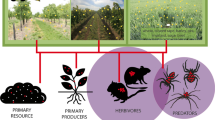Abstract
Population fluctuations in a continuous predator-prey system consisting of the spider mite,Tetranychus urticae Koch and its predator,Typhlodromus occidentalis Nesbitt, were assessed for almost 2 years (ca. 50 prey generations), on six mini-orchards of young apple trees in a climatically controlled glasshouse. During the first half of the experiment the plants were either ‘connected’ to each other with dowel rods or ‘unconnected’ and separate. In the second half, the plants were all ‘connected’. Population densities of both prey and predator on the unconnected mini-orchards were always higher than on the connected ones. Within the mini-orchards (=local scale), prey and predator populations go through a pattern of large amplitude cycles which continued throughout the experimental period. At the regional scale (mean over all mini-orchards) two types of fluctuations were observed. Large amplitude fluctuations associated with synchrony of the local cycles and small amplitude fluctuations associated with periods when local population cycles are proceeding out of phase. Transition from synchronous to asynchronous cycles took place very fast (within a few weeks), suggesting a mechanism generating asynchrony and possibly also partial refuges, which in turn trigger stabilising mechanisms at a regional scale. Causes of the synchrony are unclear. They may relate to the application of a pesticide (pirimicarb) used to control aphids, but there may just as well be an indirect form of causation, e.g. whereby the factors that promote aphid outbreaks also promote spider-mite population growth and temporary escape from control by the predators. Despite the synchronising factors the predator-prey system persisted, without external inputs, at a fairly small spatial scale, the size of a small glasshouse. Assessing the spatial scale and heterogeneity whereby decoupling of local cycles is sufficient for the cycles to proceed out of phase, remains an important area of experimental research. The experiment reported here provides some first clues and may form a standard for forthcoming experiments to assess the mechanisms promoting asynchrony, persistence and possibly also stability.
Similar content being viewed by others
References
Andrewartha, H.G. and Birch, L.C., 1954. The Distribution and Abundance of Animals. University of Chicago Press, Chicago, 782 pp.
Burnett, T., 1979. An acarine predator-prey population infesting roses. Res. Popul. Ecol., 20: 227–234.
Chesson, P.L. and Murdoch, W.W., 1986. Aggregation of risk: relationships among host-parasitoid models. Am. Nat., 127: 696–715.
Fujita, K., 1983. Systems analysis of an acarine predator-prey system II. Interactions in discontinuous environment. Res. Popul. Ecol., 25: 387–399.
Gurney, W.S.C. and Nisbet, R.M., 1978. Single-species population fluctuations in patchy environments. Am. Nat., 112: 1075–1090.
Hassell, M.P. and May, R.M., 1974. Aggregation of predators and insect parasites and its effect on stability. J. Anim. Ecol., 43: 567–594.
Hilborn, R., 1975. The effect of spatial heterogeneity on the persistence of predator-prey interactions. Theor. Popul. Biol., 8: 346–355.
Hoyt, S.C., 1969. Integrated chemical control of insects and biological control of mites on apple in Washington. J. Econ. Entomol., 62: 74–86.
Huffaker, C.B., 1958. Experimental studies on predation: Dispersion factors and predator-prey oscillations. Hilgardia, 27: 343–383.
Huffaker, C.B., Shea, K.P. and Herman, S.G., 1963. Experimental studies on predation: Complex dispersion and levels of food in an acarine predator-prey interaction. Hilgardia, 34: 305–330.
Johnson, J.F., Penrose, L.J. and Thwaite, W.G., 1979. Deciduous Fruits Spray Calendar 19th Edition. New South Wales Department of Agriculture, Sydney, 108 pp.
Lingeman, R., and van de Klashorst, G., 1992. Local and global cycles in an acarine predator-prey system: a frequency domain analysis. Exp. Appl. Acarol., 14: 201–214.
Maynard Smith, J., 1974. Models in Ecology. Cambridge University Press, Cambridge, 146 pp.
McMurtry, J.A. and van de Vrie, M., 1973. Ecology of tetranychid mites and predation byAmblyseius potentillae (Garman) onPanonychus ulmi (Koch) in simple ecosystems (Acarina: Phytoseiidae, Tetranychidae). Hilgardia, 42: 17–34.
Morisita, M., 1962. Iδ-index, a measure of dispersion of individuals. Res. Popul. Ecol., 4: 1–7.
Murdoch, W.W., Chesson, J. and Chesson, P.L., 1985. Biological control in theory and practice. Am. Nat., 125: 344–366.
Nachman, G., 1981. Temporal and spatial dynamics of an acarine predator-prey system. J. Anim. Ecol., 50: 435–451.
Nachman, G., 1987a. Systems analysis of acarine predator-prey interactions. I. A stochastic simulation model of spatial processes. J. Anim. Ecol., 56: 247–265.
Nachman, G., 1987b. Systems analysis of acarine predator-prey interactions. II. The role of spatial processes in system stability. J. Anim. Ecol., 56: 267–281.
Readshaw, J.L., 1975. The ecology of tetranychid mites in Australian orchards. J. Appl. Ecol., 12: 473–495.
Sabelis, M.W. and Diekmann, O., 1988. Overall population stability despite local extinction: the stabilizing influence of prey dispersal from predator-invaded patches. Theor. Popul. Biol., 34: 169–176.
Sabelis, M.W., Diekmann, O. and Jansen, V.A.A., 1991. Metapopulation persistence despite local extinction: predator-prey patch models of the Lotka-Volterra type. Biol. J. Linnean Soc., 42: 267–283.
Takafuji, A., Tsuda, Y. and Miki, T., 1983. System behaviour in predator-prey interaction, with special reference to acarine predator-prey system. Res. Popul. Ecol., Suppl. 3: 75–92.
Taylor, A.D., 1988. Large-scale spatial structure and population dynamics in arthropod predator-prey systems. Ann. Zool. Fenn., 25: 63–74.
Taylor, L.R., 1961. Aggregation, variance and the mean. Nature, 189: 732–735.
Taylor, L.R., 1965. A natural law for the spatial disposition of insects. Proceedings XII International Congress of Entomology, London, pp. 396–397.
Woolhouse, M.E.J. and Harmsen, R., 1987. Prey-predator cycles and lags in space: Descriptive models from a laboratory experiment. Theor. Popul. Biol., 32: 366–382.
Author information
Authors and Affiliations
Rights and permissions
About this article
Cite this article
van de Klashorst, G., Les Readshaw, J., Sabelis, M.W. et al. A demonstration of asynchronous local cycles in an acarine predator-prey system. Exp Appl Acarol 14, 185–199 (1992). https://doi.org/10.1007/BF01200563
Issue Date:
DOI: https://doi.org/10.1007/BF01200563




